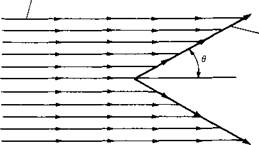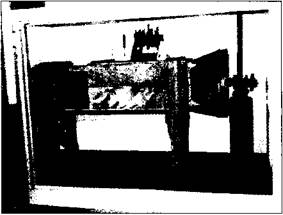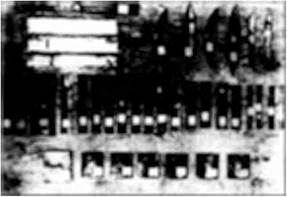Thoughts
The term “aerodynamics” is generally used for problems arising from flight and other topics involving the flow of air.
Ludwig Prandtl, 1949
Aerodynamics: The dynamics of gases, especially atmospheric interactions with moving objects.
The American Heritage Dictionary of the English Language, 1969
1.1 Importance of Aerodynamics: Historical Examples
On August 8, 1588, the waters of the English Channel churned with the gyrations of hundreds of warships. The great Spanish Armada had arrived to carry out an invasion of Elizabethan England and was met head-on by the English fleet under the command of Sir Francis Drake. The Spanish ships were large and heavy; they were packed with soldiers and carried formidable cannons that fired 50 lb round shot that could devastate any ship of that era. In contrast, the English ships were smaller and lighter; they carried no soldiers and were armed with lighter, shorter-range cannons.
The balance of power in Europe hinged on the outcome of this naval encounter. King Philip II of Catholic Spain was attempting to squash Protestant England’s rising influence in the political and religious affairs of Europe; in turn, Queen Elizabeth I was attempting to defend the very existence of England as a sovereign state. In fact, on that crucial day in 1588, when the English floated six fire ships into the Spanish formation and then drove headlong into the ensuing confusion, the future history of Europe was in the balance. In the final outcome, the heavier, sluggish, Spanish ships were no match for the faster, more maneuverable, English craft, and by that evening the Spanish Armada lay in disarray, no longer a threat to England. This naval battle is of particular importance because it was the first in history to be fought by ships on both sides powered completely by sail (in contrast to earlier combinations of oars and sail), and it taught the world that political power was going to be synonymous with naval power. In turn, naval power was going to depend greatly on the speed and maneuverability of ships. To increase the speed of a ship, it is important to reduce the resistance created by the water flow around the ship’s hull. Suddenly, the drag on ship hulls became an engineering problem of great interest, thus giving impetus to the study of fluid mechanics.
This impetus hit its stride almost a century later, when, in 1687, Isaac Newton (1642-1727) published his famous Principia, in which the entire second book was devoted to fluid mechanics. Newton encountered the same difficulty as others before him, namely, that the analysis of fluid flow is conceptually more difficult than the dynamics of solid bodies. A solid body is usually geometrically well defined, and its motion is therefore relatively easy to describe. On the other hand, a fluid is a “squishy” substance, and in Newton’s time it was difficult to decide even how to qualitatively model its motion, let alone obtain quantitative relationships. Newton considered a fluid flow as a uniform, rectilinear stream of particles, much like a cloud of pellets from a shotgun blast. As sketched in Figure 1.1, Newton assumed that upon striking a surface inclined at an angle в to the stream, the particles would
|
|
|
|
|

transfer their normal momentum to the surface but their tangential momentum would be preserved. Hence, after collision with the surface, the particles would then move along the surface. This led to an expression for the hydrodynamic force on the surface which varies as sin2 9. This is Newton’s famous sine-squared law (described in detail in Chapter 14). Although its accuracy left much to be desired, its simplicity led to wide application in naval architecture. Later, in 1777, a series of experiments was carried out by Jean LeRond d’Alembert (1717-1783), under the support of the French government, in order to measure the resistance of ships in canals. The results showed that “the rule that for oblique planes resistance varies with the sine square of the angle of incidence holds good only for angles between 50 and 90° and must be abandoned for lesser angles.” Also, in 1781, Leonhard Euler(1707-1783)pointed out the physical inconsistency of Newton’s model (Figure 1.1) consisting of a rectilinear stream of particles impacting without warning on a surface. In contrast to this model, Euler noted that the fluid moving toward a body “before reaching the latter, bends its direction and its velocity so that when it reaches the body it flows past it along the surface, and exercises no other force on the body except the pressure corresponding to the single points of contact.” Euler went on to present a formula for resistance which attempted to take into account the shear stress distribution along the surface, as well as the pressure distribution. This expression became proportional to sin2 в for large incidence angles, whereas it was proportional to sin 9 at small incidence angles. Euler noted that such a variation was in reasonable agreement with the ship-hull experiments carried out by d’Alembert.
This early work in fluid dynamics has now been superseded by modern concepts and techniques. (However, amazingly enough, Newton’s sine-squared law has found new application in very high-speed aerodynamics, to be discussed in Chapter 14.) The major point here is that the rapid rise in the importance of naval architecture after the sixteenth century made fluid dynamics an important science, occupying the minds of Newton, d’Alembert, and Euler, among many others. Today, the modem ideas of fluid dynamics, presented in this book, are still driven in part by the importance of reducing hull drag on ships.
Consider a second historical example. The scene shifts to Kill Devil Hills, 4 mi south of Kitty Hawk, North Carolina. It is summer of 1901, and Wilbur and Orville Wright are struggling with their second major glider design, the first being a stunning failure the previous year. The airfoil shape and wing design of their glider are based on aerodynamic data published in the 1890s by the great German aviation pioneer Otto Lilienthal (1848-1896) and by Samuel Pierpont Langley (1934-1906), secretary of the Smithsonian Institution—the most prestigious scientific position in the United States at that time. Because their first glider in 1900 produced no meaningful lift, the Wright brothers have increased the wing area from 165 to 290 ft2 and have increased the wing camber (a measure of the airfoil curvature—the larger the camber, the more “arched” is the thin airfoil shape) by almost a factor of 2. But something is still wrong. In Wilbur’s words, the glider’s “lifting capacity seemed scarcely one-third of the calculated amount.” Frustration sets in. The glider is not performing even close to their expectations, although it is designed on the basis of the best available aerodynamic data. On August 20, the Wright brothers despairingly pack themselves
aboard a train going back to Dayton, Ohio. On the ride back, Wilbur mutters that “nobody will fly for a thousand years.” However, one of the hallmarks of the Wrights is perseverance, and within weeks of returning to Dayton, they decide on a complete departure from their previous approach. Wilbur later wrote that “having set out with absolute faith in the existing scientific data, we were driven to doubt one thing after another, until finally after two years of experiment, we cast it all aside, and decided to rely entirely upon our own investigations.” Since their 1901 glider was of poor aerodynamic design, the Wrights set about determining what constitutes good aerodynamic design. In the fall of 1901, they design and build a 6 ft long, 16 in square wind tunnel powered by a two-bladed fan connected to a gasoline engine. An original photograph of the Wrights’ tunnel in their Dayton bicycle shop is shown in Figure 1.2a. In this wind tunnel they test over 200 different wing and airfoil shapes, including flat plates, curved plates, rounded leading edges, rectangular and curved planforms, and various monoplane and multiplane configurations. A sample of their test models is shown in Figure 1.2b. The aerodynamic data is taken logically and carefully. It shows a major departure from the existing “state-of-the-art” data. Armed with their new aerodynamic information, the Wrights design a new glider in the spring of 1902. The airfoil is much more efficient; the camber is reduced considerably, and the location of the maximum rise of the airfoil is moved closer to the front of the wing. The most obvious change, however, is that the ratio of the length of the wing (wingspan) to the distance from the front to the rear of the airfoil (chord length) is increased from 3 to 6. The success of this glider during the summer and fall of 1902 is astounding; Orville and Wilbur accumulate over a thousand flights during this period. In contrast to the previous year, the Wrights return to Dayton flushed with success and devote all their subsequent efforts to powered flight. The rest is history.
The major point here is that good aerodynamics was vital to the ultimate success of the Wright brothers and, of course, to all subsequent successful airplane designs up to the present day. The importance of aerodynamics to successful manned flight goes without saying, and a major thrust of this book is to present the aerodynamic fundamentals that govern such flight.
Consider a third historical example of the importance of aerodynamics, this time as it relates to rockets and space flight. High-speed, supersonic flight had become a dominant feature of aerodynamics by the end of World War II. By this time, aerody – namicists appreciated the advantages of using slender, pointed body shapes to reduce the drag of supersonic vehicles. The more pointed and slender the body, the weaker the shock wave attached to the nose, and hence the smaller the wave drag. Consequently, the German V-2 rocket used during the last stages of World War II had a pointed nose, and all short-range rocket vehicles flown during the next decade followed suit. Then, in 1953, the first hydrogen bomb was exploded by the United States. This immediately spurred the development of long-range intercontinental ballistic missiles (ICBMs) to deliver such bombs. These vehicles were designed to fly outside the region of the earth’s atmosphere for distances of 5000 mi or more and to reenter the atmosphere at suborbital speeds of from 20,000 to 22,000 ft/s. At such high velocities, the aerodynamic heating of the reentry vehicle becomes severe, and this heating problem dominated the minds of high-speed aerodynamicists. Their first
|
(a) |
|
(b) Figure 1 Л (a) Wind tunnel designed, built, and used by the Wright brothers in Dayton, Ohio, during 1901-1902. (b) Wing models tested by the Wright brothers in their wind tunnel during 1901-1902. |
thinking was conventional—a sharp-pointed, slender reentry body. Efforts to minimize aerodynamic heating centered on the maintenance of laminar boundary layer flow on the vehicle’s surface; such laminar flow produces far less heating than turbulent flow (discussed in Chapters 15 and 19). However, nature much prefers turbulent flow, and reentry vehicles are no exception. Therefore, the pointed-nose reentry body was doomed to failure because it would burn up in the atmosphere before reaching the earth’s surface.
However, in 1951, one of those major breakthroughs that come very infrequently in engineering was created by H. Julian Allen at the NACA (National Advisory Committee for Aeronautics) Ames Aeronautical Laboratory—he introduced the concept of the blunt reentry body. His thinking was paced by the following concepts. At the beginning of reentry, near the outer edge of the atmosphere, the vehicle has a large amount of kinetic energy due to its high velocity and a large amount of potential energy due to its high altitude. However, by the time the vehicle reaches the surface of the earth, its velocity is relatively small and its altitude is zero; hence, it has virtually no kinetic or potential energy. Where has all the energy gone? The answer is that it has gone into (1) heating the body and (2) heating the airflow around the body. This is illustrated in Figure 1.3. Here, the shock wave from the nose of the vehicle heats the airflow around the vehicle; at the same time, the vehicle is heated by the intense frictional dissipation within the boundary layer on the surface. Allen reasoned that if more of the total reentry energy could be dumped into the airflow, then less would be available to be transferred to the vehicle itself in the form of heating. In turn, the way to increase the heating of the airflow is to create a stronger shock wave at the nose, i. e., to use a blunt-nosed body. The contrast between slender and blunt reentry bodies is illustrated in Figure 1.4. This was a stunning conclusion—to minimize aerodynamic heating, you actually want a blunt rather than a slender body. The result was so important that it was bottled up in a secret government document. Moreover, because it was so foreign to contemporary intuition, the blunt-reentry-body concept was accepted only gradually by the technical community. Over the next few years, additional aerodynamic analyses and experiments confirmed the validity of blunt reentry bodies. By 1955, Allen was publicly recognized for his work, receiving the Sylvanus Albert Reed Award of the Institute of the Aeronautical Sciences (now the American Institute of Aeronautics and Astronautics). Finally, in 1958, his work was made available to the public in the pioneering document NACA Report 1381 entitled “A Study of the Motion and Aerodynamic Heating of Ballistic Missiles Entering the


 Very highspeed flow
Very highspeed flow
Figure 1.3
|
|
 |

![]()
Earth’s Atmosphere at High Supersonic Speeds.” Since Harvey Allen’s early work, all successful reentry bodies, from the first Atlas ICBM to the manned Apollo lunar capsule, have been blunt. Incidentally, Allen went on to distinguish himself in many other areas, becoming the director of the NASA Ames Research Center in 1965, and retiring in 1970. His work on the blunt reentry body is an excellent example of the importance of aerodynamics to space vehicle design.
In summary, the purpose of this section has been to underscore the importance of aerodynamics in historical context. The goal of this book is to introduce the fundamentals of aerodynamics and to give the reader a much deeper insight to many technical applications in addition to the few described above. Aerodynamics is also a subject of intellectual beauty, composed and drawn by many great minds over the centuries. If you are challenged and interested by these thoughts, or even the least bit curious, then read on.













